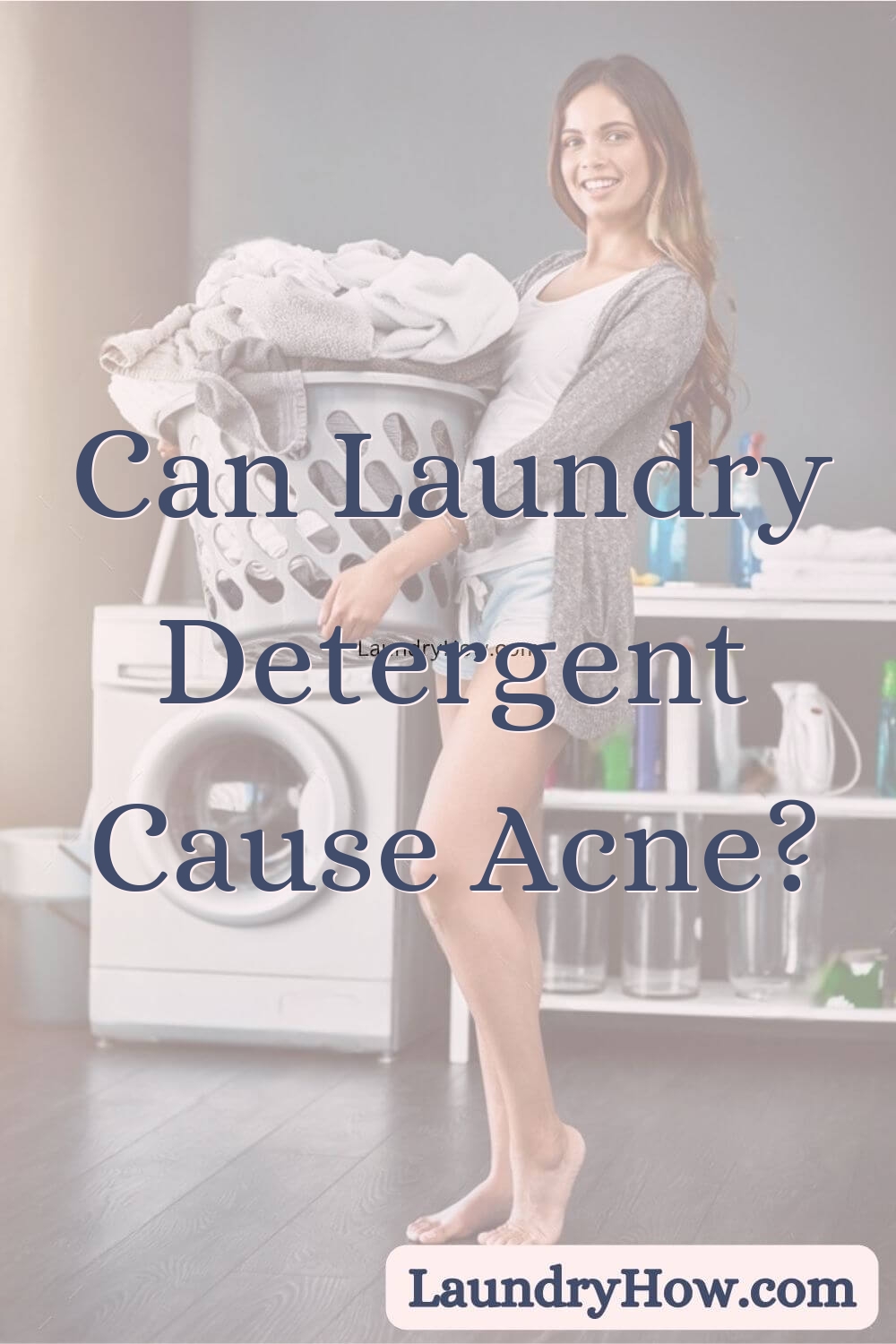Detergent is an essential household product that most of us use on a regular basis to keep our clothes and linens clean. However, some people believe that laundry detergent can contribute to skin issues like acne breakouts.
In this post, we’ll explore the question – can your choice of laundry detergent actually cause pimples?
What Is Acne and What Causes It?
Before we look at whether laundry detergent is a potential acne culprit, let’s review what acne is and what is known to cause it.
Acne is a common skin condition that occurs when hair follicles become plugged with oil and dead skin cells. At its mildest, acne causes whiteheads, blackheads, and small pimples. More inflamed, reddish pimples and deeper bumps can happen with moderate to severe acne. Acne most often occurs on the face, but can also develop on the back, chest, neck, shoulders, and upper arms.
Acne flare-ups arise from a variety of factors:
- Excess oil production – When too much sebum is produced, it can mix with dead skin cells and clog pores. This provides the ideal environment for pimples to form.
- Hormones – Acne often begins at puberty because hormone increases stimulate sebum production. Hormonal changes before a woman’s period can also trigger temporary breakouts.
- Bacteria – The bacteria Propionibacterium acnes, which naturally lives on skin, can multiply quickly within clogged follicles and cause inflammation.
- Genetics – Some people inherit a higher predisposition for acne.
- Medications – Certain medications like steroids, testosterone, or lithium are associated with acne flares.
- Stress – Increased stress levels raise cortisol and can exacerbate acne.
Are Ingredients in Laundry Detergent Implicated in Acne?
Now that we understand what’s behind acne, we can specifically look at whether using laundry detergent could be one of those contributing factors.
1. Fragrance
Some laundry detergents contain added perfumes and fragrances. Artificial fragrances are one group of ingredients that some dermatologists do link to acne flares in susceptible people.
The American Academy of Dermatology explains that fragrance mixes are made up of thousands of chemicals. Traces of the fragrances can remain on clothing after washing and transfer to your skin. For those prone to acne, these fragrance components may irritate skin and trigger breakouts.
2. Preservatives
Laundry detergents also require preservative ingredients to prevent mold, bacteria, and spoilage during storage. Common preservatives used include formaldehyde, parabens, triclosan, and benzethonium chloride. Several of these preservative chemicals are considered possible acne triggers when in contact with facial skin.
3. Irritants
Some ingredients added to laundry detergents for effective cleaning could aggravate sensitive skin if they remain in clothes after rinsing. Skin irritants like synthetic dyes, optical brighteners, sodium hypochlorite bleach, and sodium lauryl sulfate (SLS) are examples. However, amounts left in fabrics after complete machine washing cycles are very small.
4. Hard Water Minerals
Hard water contains higher levels of minerals like calcium, magnesium, and metal ions that make it more difficult to work up a soapy lather. To counteract hard water, laundry detergents use chelating agents and water softeners. These can bind to the mineral ions so they don’t interfere with cleaning. But some speculate that any excess left on laundry could theoretically affect acne-prone complexions.
Tips to Minimize Acne Risk from Laundry
While the amount of evidence that your laundry detergent directly causes breakouts is slim and inconclusive, you can take a few simple precautions:
- Pick an unscented, fragrance-free detergent option.
- Look for laundry products labeled non-comedogenic or acne-friendly.
- Choose gentle, plant-based laundry detergent formulas when possible.
- Use an extra rinse cycle to remove more residual detergent.
- Change and wash bedsheets, pillowcases, towels, and face cloths more frequently to avoid transfer of oils, skin cells, bacteria, and traces of laundry detergent chemicals to your face.
- Wash new clothing a couple of times before wearing. The manufacturing process can leave extra irritating dyes, formaldehyde finishes, or sizing starches behind in fabrics.
The Bottom Line
While research hasn’t confirmed that your choice of laundry detergent is a significant factor in causing acne breakouts, experts do agree it likely plays a small role for those with very sensitive or reactive skin:
- Ingredients like fragrance and preservatives that remain in washed laundry can potentially irritate skin and worsen acne in prone individuals.
- Laundry detergents formulated for sensitive skin are less likely to lead to irritation or allergic reactions.
- Good cleansing and rinsing help remove traces of detergent, but can’t eliminate all residues.
- Changing pillowcases regularly prevents transfer of oils and bacteria from your face to fabric.
Overall, research hasn’t found that laundry detergent alone is a major direct cause of acne. Genetics, hormones, excess oil, and bacteria growth within clogged pores drive most breakouts. But for some, detergent ingredients may provide added inflammation or irritation that contributes to existing acne flare-ups. Testing gentler detergents and avoiding fragrances can help if you suspect a laundry product reaction.
References
American Academy of Dermatology. (2022). Acne products: Fact vs fiction. Retrieved from https://www.aad.org/public/diseases/acne/causes/acne-products
American Cleaning Institute. (2020). Understanding laundry detergent ingredients. Retrieved from https://www.cleaninginstitute.org/understanding-products/laundry-detergent-ingredients
Baquerizo Nole KL, Yim E, Keri J. (2020). Probiotics and prebiotics in dermatology. Journal of the American Academy of Dermatology. 82(3):814-821. doi:10.1016/j.jaad.2018.11.058
Bendsoe N, Björnberg A, Andersson AC, et al. (2019). Allergic contact dermatitis from preservatives in facial moisturizers. Contact Dermatitis. 80(6):377-383. doi:10.1111/cod.13250
Bhate K, Williams HC. (2013). Epidemiology of acne vulgaris. The British Journal of Dermatology. 168(3):474-485. doi:10.1111/bjd.12149
Das N, Reynolds RV. (2014). Does the use of hormonal contraceptives exacerbate acne?. A systematic review. Clinical and Experimental Dermatology. 39(4):434-447; quiz 447-438. doi:10.1111/j.1365-2230.2012.04460.x
Zaenglein AL, Pathy AL, Schlosser BJ, et al. (2016). Guidelines of care for the management of acne vulgaris. Journal of the American Academy of Dermatology. 74(5):945-973.e33. doi:10.1016/j.jaad.2015.12.037

Laura has had an enthusiasm for laundry ever since she was a teenager experimenting with wash cycles. She went on study textile science in college before working in product testing.
Soon, Laura found friends and family constantly asking her laundry advice, realizing she had become an unofficial laundry guru. The questions kept coming in, so Laura decided to start sharing laundry tips online to help more people. The enthusiastic response led her start the blog “Laundry How”.
Now in her late thirties, Laura uses Laundry How to tackle all kinds of laundry topics – stains, fabric care, detergents, and more. She provides advice from both her studies and experience testing techniques out firsthand. Laura continues to grow an engaged community of laundry learners, feeling fulfilled empowering people to make laundry an easy, confidence-building ritual rather than a dreaded chore.
